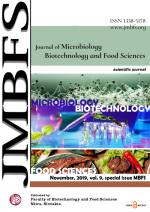CHARACTERISTICS OF CEREALS, PSEUDOCEREALS AND LEGUMES FOR THEIR COELIAC ACTIVE POLYPEPTIDES
DOI:
https://doi.org/10.15414/jmbfs.2019.9.special.390-395Keywords:
coeliac disease, cereals, pseudocereals, peas, SDS-PAGE, ELISA, Western blotAbstract
The aim of this study was to analyze two types of cereals (wheat, barley), two types of pseudocereals (buckwheat, amaranth) and one type of legumes (peas) in terms of their use in gluten-free diet. Protein content, a fractional protein complex of grain, electrophoretic separation of storage proteins in SDS-PAGE and detection of coeliac active polypeptides by ELISA and Western blot were determined in whole grain samples. Significant differences in the proportion of individual protein fractions in cereals, pseudocereals and legumes were detected. Prolamins and glutelins (63.35% - 65.25%) prevailed in cereals, while albumins and globulins (49.2% - 73.24%) showed the highest proportion in pseudocereals and legumes. The ELISA method quantified of coeliac active polypeptides, with a lower limit of gluten proteins in peas, amaranth and buckwheat. On the contrary, in wheat and barley grain, gluten protein content was found above the permitted limit of 0.02 g.kg-1. Western blot has confirmed that foods made from wheat and barley are not suitable for gluten-free diet, whereas peas, amaranth and buckwheat do not contain coeliac active polypeptides, and therefore represent a suitable source of protein for the preparation of gluten-free foods and food for coeliac patients.Downloads
Download data is not yet available.
Downloads
Published
2019-11-08
How to Cite
Gálová, Z., Rajnincová, D., Chňapek, M., Balážová, ½elmíra, Å paleková, A., Vivodík, M., & Hricová, A. (2019). CHARACTERISTICS OF CEREALS, PSEUDOCEREALS AND LEGUMES FOR THEIR COELIAC ACTIVE POLYPEPTIDES. Journal of Microbiology, Biotechnology and Food Sciences, 9(Special issue), 390–395. https://doi.org/10.15414/jmbfs.2019.9.special.390-395
Issue
Section
Biotechnology
License
Copyright (c) 2022 Zdenka Gálová, Dana Rajnincová, Milan Chňapek, ŽelmÃÂra Balážová, Andrea Å paleková, Martin VivodÃk, Andrea Hricová

This work is licensed under a Creative Commons Attribution 4.0 International License.
All papers published in the Journal of Microbiology, Biotechnology and Food Sciences are published under a CC-BY licence (CC-BY 4.0). Published materials can be shared (copy and redistribute the material in any medium or format) and adapted (remix, transform, and build upon the material for any purpose, even commercially) with specifying the author(s).





